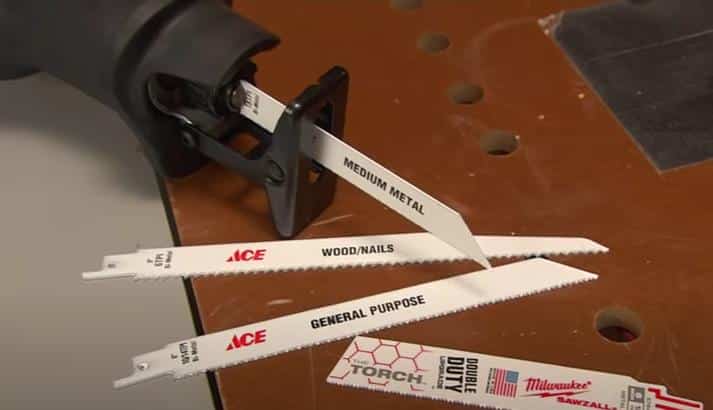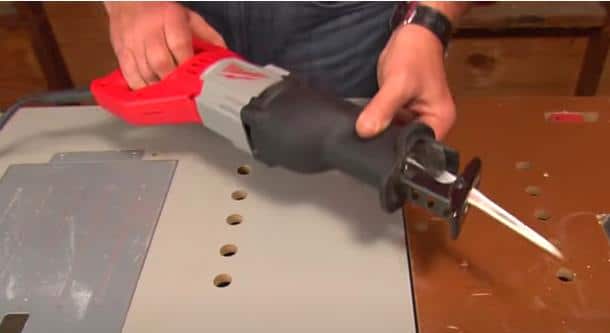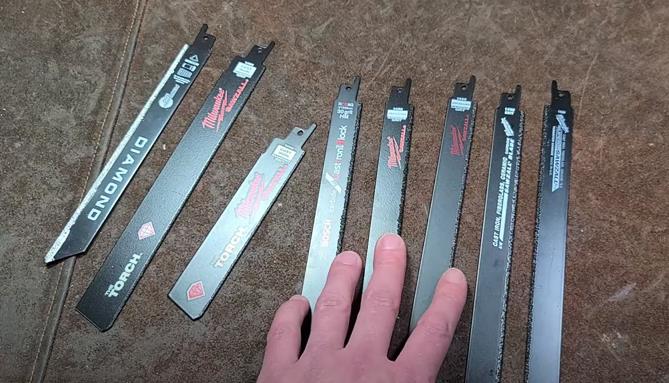Are reciprocating saw blades universal? No, they are not. Some may match, but not all. Most reciprocating saw blades are designed to be compatible with multiple brands and models of saws.
However, there are some variations between the different types of blades available, so it’s important to choose the right blade for your particular saw. For example, some blades are designed for use with metal, while others are better suited for cutting through wood.
There are also blades specifically designed for use with certain types of saws, such as cordless reciprocating saws. When choosing a reciprocating saw blade, it’s important to consider the material you’ll be cutting and the type of saw you’ll be using.
However, this article will explore the truth about universality of reciprocating saw blades and help you find the perfect blade to get the job done.
So, let’s get started.
Are Reciprocating Saw Blades Universal?

A reciprocating saw is a powerful tool that can be used to cut many different kinds of materials. But when using a reciprocating saw, one question that often comes up is whether or not the blades are universal.
The answer is not straightforward, as the compatibility of blades can vary depending on the brand and model of your reciprocating saw. Some companies make blades that only work with their own reciprocating saws, while others make blades that can be used with more than one brand or model.
When choosing a reciprocating saw blade, the shank type is an important thing to consider. There are two main types of shanks: the universal and the proprietary. Universal shank blades can be used with a wide range of reciprocating saws, while proprietary shank blades are made to fit only certain models or brands.
It’s also important to consider the blade’s length and thickness, which can affect how well the saw works. Longer blades can give you more reach, and thicker blades can be stronger and cut through harder materials.
Reciprocating saw blades come in different shapes, sizes, and materials, making choosing the right blade for the job essential. Whether cutting through wood, metal, or masonry, a blade is designed specifically for the task. Checking the blade’s compatibility with your saw is crucial to ensure it fits correctly and functions optimally.
Don’t settle for a one-size-fits-all approach to your reciprocating saw blades. Get the right blade for the job and experience the power and precision of a tool designed to tackle the toughest cutting challenges.
What Is A Reciprocating Saw?
A reciprocating saw is a powerful tool that cuts through materials using a reciprocating motion of the blade.

A reciprocating saw is a powerful tool that helps make quick work of tough cuts. It’s also called a “recip saw” or a “sawzall” (the brand name of a popular reciprocating saw). The reciprocating saw has a blade that moves rapidly back and forth, allowing it to cut through wood, metal, and plastic.
One of the big advantages of a reciprocating saw is that it can be used in tight spaces where it would be difficult to use a larger power saw. It’s also relatively lightweight and easy to handle, making it a good choice for many home improvement projects.
What Are The Different Types Of Reciprocating Saws?
The different types of reciprocating saws are cordless, electric, and pneumatic.
A reciprocating saw is a power tool that helps quickly cut through various materials. The saw’s blade moves back and forth reciprocally, allowing it to cut through material quickly and efficiently. Different reciprocating saws are available on the market, each designed for specific tasks.
Here is a look at the different types of reciprocating saws and what they are best suited for:
1. Standard Reciprocating Saw:
A standard reciprocating saw is the most common type of saw available. It is versatile and can be used for various tasks, such as cutting through wood, metal, or plastic.
2. Compact Reciprocating Saw:
A compact reciprocating saw is a smaller version of a standard saw. It is designed for tight spaces and can be used for cutting pipes or conduits.
3. Cordless Reciprocating Saw:
A cordless reciprocating saw is a battery-operated saw that offers the convenience of not being tethered to a power source. It is ideal for use when a power outlet is not readily available.
4. Variable Speed Reciprocating Saw:
A variable speed reciprocating saw allows the user to adjust the speed of the blade depending on the material being cut. This is handy when cutting through materials that require different speeds, such as wood and metal.
5. Jigsaw Reciprocating Saw:
A jigsaw reciprocating saw is a specialized saw that is designed for making curved or intricate cuts. It is often used by woodworkers or those who need to make precise cuts in materials.
No matter what type of reciprocating saw you need, there is sure to be one that fits your needs. These versatile and powerful saws make them valuable to any tool collection.
The Benefits Of Using A Reciprocating Saw
A reciprocating saw can be used for various tasks, such as cutting pipes, metal studs, and drywall.
A reciprocating saw is a versatile tool that can be used to cut wood, metal, and plastic, among other things. The saw is powered by a motor with a blade that reciprocates or moves back and forth at high speed.
The reciprocating saw is a handy tool around the house for cutting pipes, trimming tree branches, or demolishing walls. The saw is also useful for more delicate tasks, such as cutting metal hardware or plastic tubing.
One of the benefits of using a reciprocating saw is that it can be used in tight spaces. The saw’s narrow blade can be maneuvered into tight areas, making it ideal for cutting pipes or trimming branches close to the ground.
Another benefit of using a reciprocating saw is its relatively safe use. A guard covers the saw’s blade, which can be operated with one hand, leaving the other free to steady the cut material.
A reciprocating saw is a good option if you are looking for a versatile tool that can handle various tasks. The saw is relatively safe and easy to use and can be operated in tight spaces.
What Are The Parts Of A Reciprocating Saw?

The parts of a reciprocating saw are the body, handle, blade, guard, and trigger.
A reciprocating saw is a power tool that helps make quick work of slicing through materials like wood and metal. It’s a versatile tool that can be used for various applications, and it’s relatively easy to use once you understand the basics.
Now, we’ll look at the parts of a reciprocating saw so you can better understand how it works.
The Blade
The blade is the most important part of the reciprocating saw. The part does the cutting, so choosing the right blade for the job is important. Reciprocating saw blades come in various sizes and styles, so you’ll need to select the one best suited for the material you’re trying to cut.
The Handle
The handle of the reciprocating saw is where you’ll grip the tool as you’re cutting. Choosing a handle that’s comfortable for you to grip is important so you can maintain control of the tool while you’re using it.
The Trigger
The trigger is what you’ll press to start the blade moving. It’s located on the tool’s handle, and you’ll need to press it with your finger to move the blade.
The Shoe
The shoe is the part of the reciprocating saw that helps stabilize the blade as it cuts. It’s located at the base of the blade and can be adjusted to help you make straighter cuts.
How To Use A Reciprocating Saw?
Here’s a tip: when cutting, go slowly initially to get a feel for the saw. Once you get the hang of it, you can speed up.
Now let’s look at a real-life example of how to use a reciprocating saw. Let’s say you’re trying to cut through a piece of wood that’s too thick for a standard saw. You could use a handheld saw, which would be very slow and difficult. Instead, you could use a reciprocating saw.
- Start by reading the owner’s manual for your saw. This will help you understand the tool and how it works.
- Choose the right blade for the job. In this case, you’ll need a blade designed for cutting wood.
- Install the blade according to the manufacturer’s instructions.
- Plug in the saw and turn it on.
- Hold the saw with both hands and guide it through the cutting material.
- When you’re finished, turn off the saw and unplug it.
- Remove the blade and store the saw safely.
Now you know how to use a reciprocating saw. With this tool in your arsenal, you can tackle many home improvement projects.
How Does A Reciprocating Saw Work?
A reciprocating saw works by moving a blade back and forth in a rapid motion.
A reciprocating saw is a power tool that uses a reciprocating motion to cut through materials. The cutting action is created by a blade that moves back and forth linearly. This type of saw is typically used for demolition work or making rough cuts in wood, metal, or plastic.
Reciprocating saws typically have a blade that is about six inches long. The blade is mounted on a reciprocating arm connected to an electric motor. The motor powers the blade to move back and forth at a high rate of speed.
The speed of the blade and the amount of pressure applied to the material being cut will determine how deep the blade will cut. For example, a reciprocating saw can be used to cut through a piece of 1-inch thick wood. However, if the blade moves too fast or applies too much pressure, the blade can easily cut through the wood and into the user’s hand.
Reciprocating saws can be used with a variety of different blades. The most common type of blade is a metal cutting blade. However, there are also blades available for cutting wood and plastic.
When using a reciprocating saw, it is important to use the proper safety equipment. This includes eye protection and gloves. It is also a good idea to wear hearing protection because the saw can be very loud.
Reciprocating saws are a great tool for a variety of projects. They can be used to cut through materials or make precise cuts. A reciprocating saw can be a safe and easy tool with the proper safety equipment and a little practice.
Now that you know the basics of the reciprocating saw, you’re ready to get started using it. Just remember to choose the right blade for the job, and take your time cutting to ensure a clean, straight cut.
What Are Some Of The Different Types Of Reciprocating Saw Blades?

There are many different reciprocating saw blades, each designed for a specific purpose. The most common types are:
1. General-purpose blades: these are designed for cutting various materials, including wood, metal, and plastic.
2. Wood-cutting blades: these are designed specifically for cutting wood and usually have teeth spaced further apart than general-purpose blades.
3. Metal-cutting blades: these are designed specifically for cutting metal and usually have teeth spaced closer together than general-purpose blades.
4. Demolition blades: these are designed for quickly cutting through materials and will usually have very aggressive teeth.
5. Pruning blades: these are designed for cutting through thick branches and other tough materials.
6. Grit blades: these are designed for cutting through very hard materials such as concrete and stone.
FAQ
What Are Some Of The Drawbacks Of Using A Reciprocating Saw?
The reciprocating saw is a powerful tool that can make quick work of many projects. However, there are some drawbacks to using this type of saw. One is that the blade can bind in the cut material, which can cause the saw to kick back. Another is that the rapid up-and-down motion of the blade can create a lot of vibration, which can be tiring for the user. And finally, the blade can be difficult to control, leading to accidents.
Are Reciprocating Saw Blades Universal?
No, reciprocating saw blades are not universal. This is because reciprocating saw blades are designed to fit a specific type of saw. There are many different types of reciprocating saws on the market, each using different size and type of blade. So, while you may be able to find a blade that fits your saw, it may not be the right type of blade for your saw.
Final Words
Are reciprocating saw blades universal? There is no simple answer to the question of whether or not reciprocating saw blades are universal. It depends on the brand and model of the saw.
But there are many options, like universal shank blades, that can be used with different brands and models of reciprocating saws. When choosing a blade, it’s important to think about the material you’ll be cutting, its length and thickness, and the type of shank.
If you choose the right blade for your needs, a reciprocating saw can be a powerful tool that can be used for many different cutting tasks. Whether you’re a professional tradesperson or just like to do things yourself, choosing the right blade can help you cut better and faster.
Hopefully, you are clear now about reciprocating saw blades. If you still have any questions, feel free to comment below.

